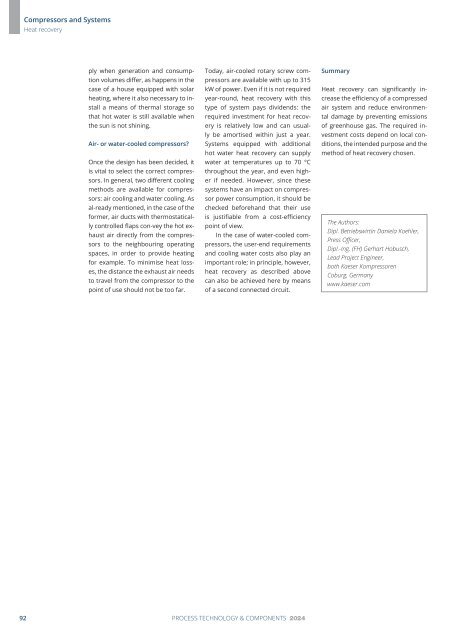PuK - Process Technology & Components 2024
A technical trade magazine with a history of more than 60 years.
A technical trade magazine with a history of more than 60 years.
Create successful ePaper yourself
Turn your PDF publications into a flip-book with our unique Google optimized e-Paper software.
Compressors and Systems<br />
Heat recovery<br />
ply when generation and consumption<br />
volumes differ, as happens in the<br />
case of a house equipped with solar<br />
heating, where it also necessary to install<br />
a means of thermal storage so<br />
that hot water is still available when<br />
the sun is not shining.<br />
Air- or water-cooled compressors?<br />
Once the design has been decided, it<br />
is vital to select the correct compressors.<br />
In general, two different cooling<br />
methods are available for compressors:<br />
air cooling and water cooling. As<br />
al-ready mentioned, in the case of the<br />
former, air ducts with thermostatically<br />
controlled flaps con-vey the hot exhaust<br />
air directly from the compressors<br />
to the neighbouring operating<br />
spaces, in order to provide heating<br />
for example. To minimise heat losses,<br />
the distance the exhaust air needs<br />
to travel from the compressor to the<br />
point of use should not be too far.<br />
Today, air-cooled rotary screw compressors<br />
are available with up to 315<br />
kW of power. Even if it is not required<br />
year-round, heat recovery with this<br />
type of system pays dividends: the<br />
required investment for heat recovery<br />
is relatively low and can usually<br />
be amortised within just a year.<br />
Systems equipped with additional<br />
hot water heat recovery can supply<br />
water at temperatures up to 70 °C<br />
throughout the year, and even higher<br />
if needed. However, since these<br />
systems have an impact on compressor<br />
power consumption, it should be<br />
checked beforehand that their use<br />
is justifiable from a cost-efficiency<br />
point of view.<br />
In the case of water-cooled compressors,<br />
the user-end requirements<br />
and cooling water costs also play an<br />
important role; in principle, how ever,<br />
heat recovery as described above<br />
can also be achieved here by means<br />
of a se cond connected circuit.<br />
Summary<br />
Heat recovery can significantly increase<br />
the efficiency of a compressed<br />
air system and reduce environmental<br />
damage by preventing emissions<br />
of greenhouse gas. The required investment<br />
costs depend on local conditions,<br />
the intended purpose and the<br />
method of heat recovery chosen.<br />
The Authors:<br />
Dipl. Betriebswirtin Daniela Koehler,<br />
Press Officer,<br />
Dipl.-Ing. (FH) Gerhart Hobusch,<br />
Lead Project Engineer,<br />
both Kaeser Kompressoren<br />
Coburg, Germany<br />
www.kaeser.com<br />
92 PROCESS TECHNOLOGY & COMPONENTS <strong>2024</strong>

















